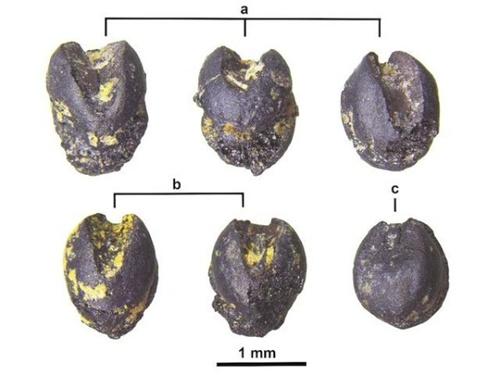
. > WHAT'S NEW > TOPLINE
Millet remains found at China's Neolithic culture site
Author : Source : Xinhua 2020-12-08

Archaeologists have discovered 33 carbonized millet grains dating back 5,300 to 5,600 years at the Qujialing site in Central China's Hubei province.[Photo provided by the Hubei Provincial Institute of Cultural Relics and Archaeology Research]
Archaeologists have discovered 33 carbonized millet grains dating back 5,300 to 5,600 years at a site in Central China, local authorities said on Monday.
The millet grains, found at the Qujialing site in Central China's Hubei province, are the earliest of its kind ever unearthed in the middle reaches of the Yangtze River, said Yao Ling, an archaeologist with the Hubei Provincial Institute of Cultural Relics and Archaeology Research.
The discovery provided new evidence that dryland farming was introduced from northern China to the region during the Neolithic period, said Yao.
Discovered in the 1950s, the Qujialing site is the most representative site of Neolithic culture in the middle reaches of Yangtse River. It was selected as one of the first 100 large site-conservation projects by the National Cultural Heritage Administration in 2005.
Over 1,200 grains of crops, including rice, wheat, and soybean, as well as a large number of pottery drinking vessels, have been unearthed at the Qujialing site over the years. It suggests the prosperity of agricultural production in the region during the Neolithic period, according to Luo Yunbing, deputy director of the Hubei Provincial Institute of Cultural Relics and Archaeology Research.
Ye Shengtao made Chinese fairy tales from a wilderness
Ye Shengtao (1894–1988) created the first collection of fairy tales in the history of Chinese children’s literature...
-
How northern ethnicities integrated into Chinese nation
2023-09-18
-
Mogao caves
2023-09-12
-
Mogao Grottoes as ‘a place of pilgrimage’
2023-09-12
-
Time-honored architectural traditions in China
2023-08-29
-
Disentangling the civilizational evolution of China
2023-08-28
-
AI ethics in science fiction
2023-08-23













 2011-2013 by www.cssn.cn. All Rights Reserved
2011-2013 by www.cssn.cn. All Rights Reserved